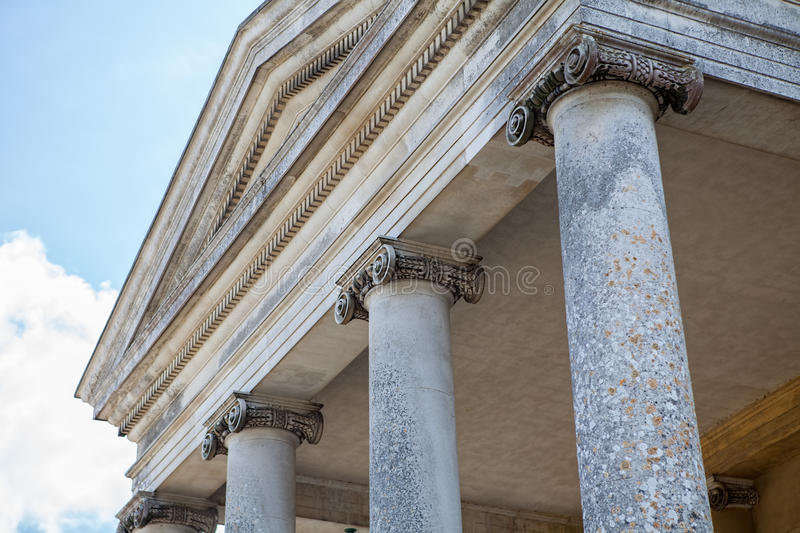architektura grecka

The two principal orders in Archaic and Classical Greek architecture are the Doric and the Ionic. In the first, the Doric order, the columns are fluted and have no base. The capitals are composed of two parts consisting of a flat slab, the abacus, and a cushionlike slab known as the echinus..Ancient Greek architects strove for the precision and excellence of workmanship that are the hallmarks of Greek art in general. The formulas they invented as early as the sixth century B.C. have influenced the architecture of the past two millennia. The two principal orders in Archaic and Classical Greek architecture are the Doric and the Ionic. In the first, the Doric order, the columns are fluted and have no base. The capitals are composed of two parts consisting of a flat slab, the abacus, and a cushionlike slab known as the echinus. On the capital rests the entablature, which is made up of three parts: the architrave, the frieze, and the cornice. The architrave is typically undecorated except for a narrow band to which are attached pegs, known as guttae. On the frieze are alternating series of triglyphs (three bars) and metopes, stone slabs frequently decorated with relief sculpture. The pediment, the triangular space enclosed by the gables at either end of the building, was often adorned with sculpture, early on in relief and later in the round. Among the best-preserved examples of Archaic Doric architecture are the temple of Apollo at Corinth, built in the second quarter of the sixth century B.C., and the temple of Aphaia at Aegina, built around 500–480 B.C. To the latter belong at least three different groups of pedimental sculpture exemplary of stylistic development between the end of the sixth and beginning of the fifth century B.C. in Attica.Ancient Greek architects strove for the precision and excellence of workmanship that are the hallmarks of Greek art in general. The formulas they invented as early as the sixth century B.C. have influenced the architecture of the past two millennia. The two principal orders in Archaic and Classical Greek architecture are the Doric and the Ionic. In the first, the Doric order, the columns are fluted and have no base. The capitals are composed of two parts consisting of a flat slab, the abacus, and a cushionlike slab known as the echinus. On the capital rests the entablature, which is made up of three parts: the architrave, the frieze, and the cornice. The architrave is typically undecorated except for a narrow band to which are attached pegs, known as guttae. On the frieze are alternating series of triglyphs (three bars) and metopes, stone slabs frequently decorated with relief sculpture. The pediment, the triangular space enclosed by the gables at either end of the building, was often adorned with sculpture, early on in relief and later in the round. Among the best-preserved examples of Archaic Doric architecture are the temple of Apollo at Corinth, built in the second quarter of the sixth century B.C., and the temple of Aphaia at Aegina, built around 500–480 B.C. To the latter belong at least three different groups of pedimental sculpture exemplary of stylistic development between the end of the sixth and beginning of the fifth century B.C. in Attica. Οι δύο κύριες τάξεις στην αρχαϊκή και την κλασική ελληνική αρχιτεκτονική είναι η δωρική και η ιωνική. Στην πρώτη, δωρικού ρυθμού, οι κίονες είναι αυλακωτοί και δεν έχουν βάση. Τα κιονόκρανα αποτελούνται από δύο μέρη που αποτελούνται από μια επίπεδη πλάκα, τον άβακα, και μια μαξιλαροειδή πλάκα γνωστή ως εχίνος. Οι αρχαίοι Έλληνες αρχιτέκτονες προσπάθησαν για την ακρίβεια και την αριστεία της κατασκευής που είναι τα χαρακτηριστικά της ελληνικής τέχνης γενικότερα. Οι φόρμουλες που επινόησαν ήδη από τον έκτο αιώνα π.Χ. έχουν επηρεάσει την αρχιτεκτονική των δύο προηγούμενων χιλιετιών. Οι δύο κύριες τάξεις στην αρχαϊκή και την κλασική ελληνική αρχιτεκτονική είναι η δωρική και η ιωνική. Στην πρώτη, δωρικού ρυθμού, οι κίονες είναι αυλακωτοί και δεν έχουν βάση. Τα κιονόκρανα αποτελούνται από δύο μέρη που αποτελούνται από μια επίπεδη πλάκα, τον άβακα και μια πλάκα που μοιάζει με μαξιλάρι, γνωστή ως εχίνος. Στο κιονόκρανο στηρίζεται το θριγκό, το οποίο αποτελείται από τρία μέρη: το επιστύλιο, τη ζωφόρο και το γείσο. Το επιστύλιο είναι συνήθως ακόσμητο, εκτός από μια στενή ταινία στην οποία συνδέονται μανταλάκια, γνωστά ως guttae. Στη ζωφόρο εναλλάσσονται σειρές από τρίγλυφα (τρεις ράβδους) και μετόπες, πέτρινες πλάκες συχνά διακοσμημένες με ανάγλυφα γλυπτά. Το αέτωμα, ο τριγωνικός χώρος που περικλείεται από τα αετώματα εκατέρωθεν του κτιρίου, συχνά κοσμούνταν με γλυπτική, νωρίς σε ανάγλυφο και αργότερα σε στρογγυλό. Ανάμεσα στα καλύτερα διατηρημένα παραδείγματα αρχαϊκής δωρικής αρχιτεκτονικής είναι ο ναός του Απόλλωνα στην Κόρινθο, που χτίστηκε το δεύτερο τέταρτο του έκτου αιώνα π.Χ., και ο ναός της Αφαίας στην Αίγινα, που χτίστηκε γύρω στο 500–480 π.Χ. Στην τελευταία ανήκουν τουλάχιστον τρεις διαφορετικές ομάδες αετωματικής γλυπτικής υποδειγματικής υφολογικής εξέλιξης μεταξύ του τέλους του έκτου και των αρχών του πέμπτου αιώνα π.Χ. στην Αττική.Οι αρχαίοι Έλληνες αρχιτέκτονες προσπάθησαν για την ακρίβεια και την αριστεία της κατασκευής που είναι τα χαρακτηριστικά της ελληνικής τέχνης γενικότερα. Οι φόρμουλες που επινόησαν ήδη από τον έκτο αιώνα π.Χ. έχουν επηρεάσει την αρχιτεκτονική των δύο προηγούμενων χιλιετιών. Οι δύο κύριες τάξεις στην αρχαϊκή και την κλασική ελληνική αρχιτεκτονική είναι η δωρική και η ιωνική. Στην πρώτη, δωρικού ρυθμού, οι κίονες είναι αυλακωτοί και δεν έχουν βάση. Τα κιονόκρανα αποτελούνται από δύο μέρη που αποτελούνται από μια επίπεδη πλάκα, τον άβακα και μια πλάκα που μοιάζει με μαξιλάρι, γνωστή ως εχίνος. Στο κιονόκρανο στηρίζεται το θριγκό, το οποίο αποτελείται από τρία μέρη: το επιστύλιο, τη ζωφόρο και το γείσο. Το επιστύλιο είναι συνήθως ακόσμητο, εκτός από μια στενή ταινία στην οποία συνδέονται μανταλάκια, γνωστά ως guttae. Στη ζωφόρο εναλλάσσονται σειρές από τρίγλυφα (τρεις ράβδους) και μετόπες, πέτρινες πλάκες συχνά διακοσμημένες με ανάγλυφα γλυπτά. Το αέτωμα, ο τριγωνικός χώρος που περικλείεται από τα αετώματα εκατέρωθεν του κτιρίου, συχνά κοσμούνταν με γλυπτική, νωρίς σε ανάγλυφο και αργότερα σε στρογγυλό. Ανάμεσα στα καλύτερα διατηρημένα παραδείγματα αρχαϊκής δωρικής αρχιτεκτονικής είναι ο ναός του
